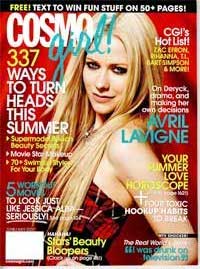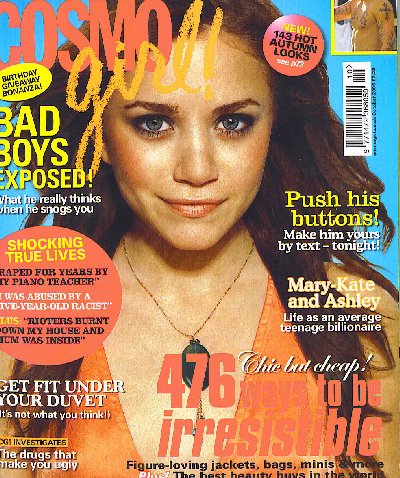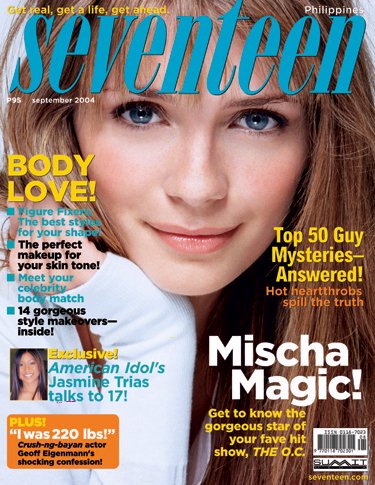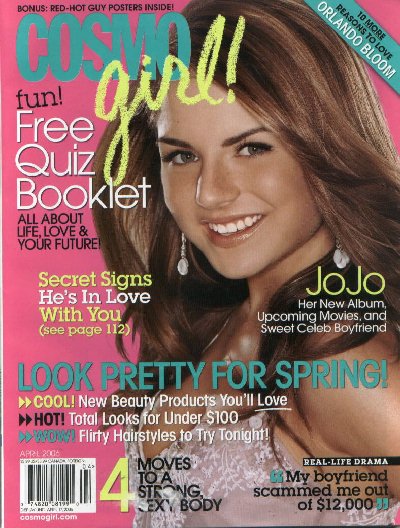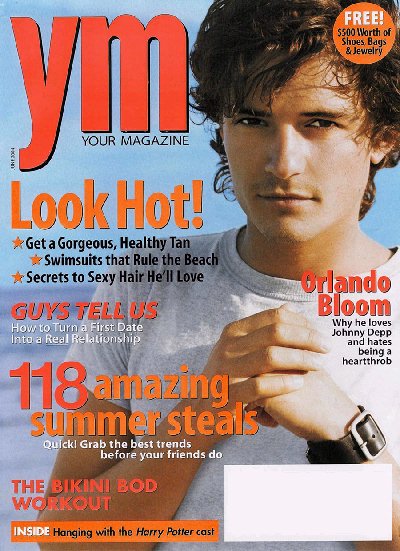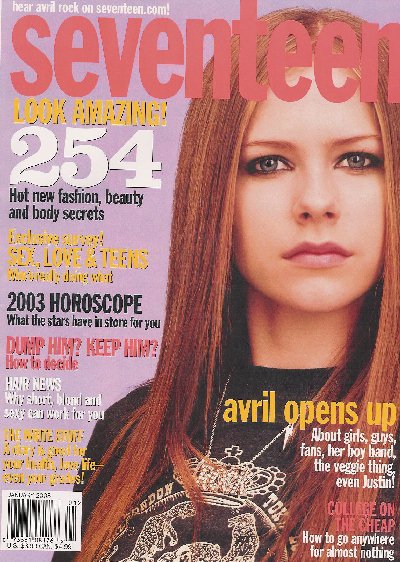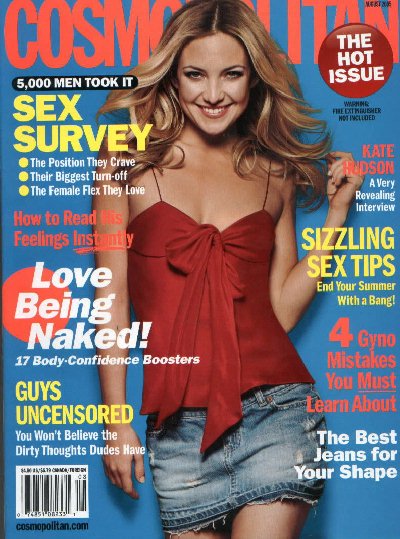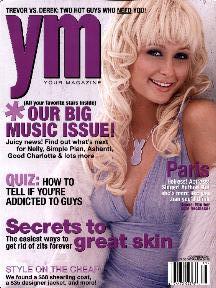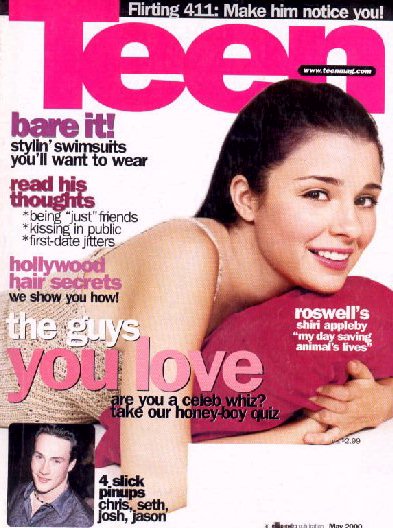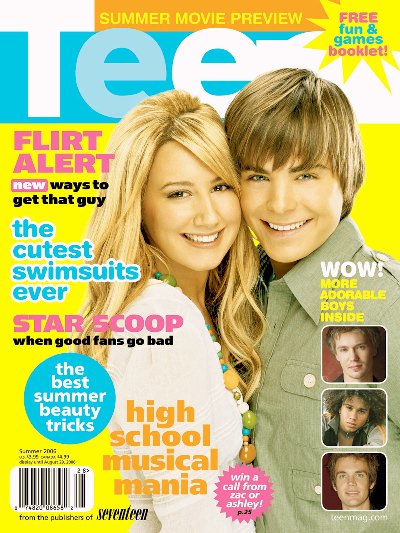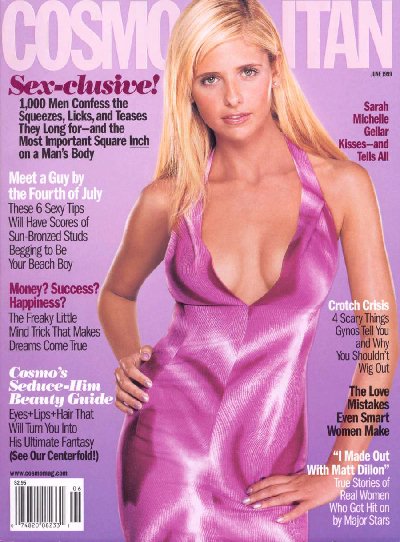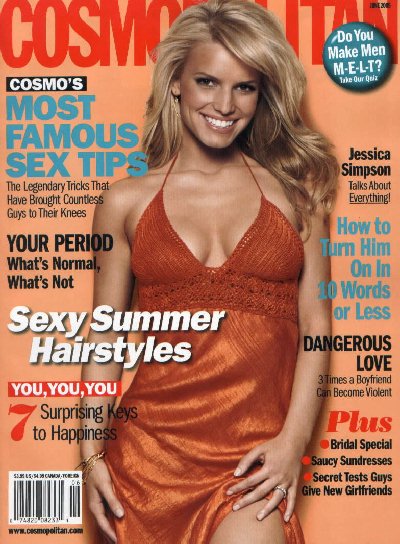 |
||||
|
Teen Magazines Vs. Adolescent Girls
Magazines: What Adolescent Girls are Reading and the Way They Shape Body ImageBy Heidi Sauer & Rebecca Robles-Piña, Ph.D. - 2003
THE RIGHT WAY TO KISS.
These are headlines in current issues of popular teen magazines Seventeen, CosmoGIRL, and YM. The number of teenagers in this country is on the rise, and magazines and advertisers are desperately vying for the billions of dollars of discretionary income that teenagers spend on entertainment (Dobosz, 2001). However, the teen market is fragmented and fickle, so magazine publishers struggle to keep up with shifting tastes (Merrill, 1999). The traditional "big three" teen magazines are Seventeen, YM, and Teen (Dobosz, 2001; Merrill, 1999; Norton, 2001; Thomsen, Weber, & Brown, 2002). Just these three magazines have a combined readership of over 10 million (Norton, 2001). While the popularity of these three giants is incontrovertible, teenage magazine readers have recently been given more options to choose from. In 1998, People magazine introduced Teen People into the market (Dobosz, 2001). This magazine is notable for drawing both male and female teen readers by featuring topics, such as celebrities, interracial dating, and school shootings that are relevant to both genders. To keep up with ever-changing audience interests, Teen People hires "trendspotters" who test new products and take surveys (Merrill, 1999). Dobosz (2001) reported that, in the wake of the successful launch of Teen People, three new teen magazines were unveiled between the summer of 1999 and the summer of 2000, and all three are offspring of successful adult magazines: CosmoGIRL, Teen Vogue, and MH-18 (from Men's Health). These magazines focus heavily on celebrity and incorporate real-life teen stories, not just the beauty, fashion, and romance information typically found in teen magazines. Not surprisingly, these magazines are rich with advertisements for clothing, cosmetics, perfumes, personal hygiene, and gadgets. Because of their young audience, the advertisers in these magazines target low- to mid-price budgets (unlike the adult versions of these magazines), are trendy, and feature age-appropriate models. Layout and design is bold and bright with boxed information, web addresses, nontraditional fonts, and text rife with slang (Dobosz, 2001). Such measures may draw in readers, but what does one find inside these magazines? It is important to evaluate the messages, both actual and implied, that teenage girls take from the magazines they read.
For example, the major topic in these magazines is dieting. Dieting is the primary method most females choose to lose unwanted weight (McCabe & Ricciardelli, 2001). At any one time, as many as two-thirds of all high school girls are either on a diet or are planning to be on one soon (Thomsen et al., 2001; Thomsen et al., 2002). Research implies that most teens do not choose healthy methods of weight loss; they take diet pills, force themselves to throw up, and restrict daily caloric intake to dangerously low levels (Thomsen et al., 2001; Thomsen et al., 2002). These behaviors can result in development of disorders such as anorexia and bulimia. These eating disorders typically manifest in adolescent girls because these are the years when they are particularly sensitive to cultural pressure to be thin (Thomsen et al., 2002). As Currie said in Girl Talk: Adolescent Magazines and Their Readers, "our core identities are social projects, not biological destiny" (1999, p. 3). So, how do we explain this cultural phenomenon of a thin ideal? Stice's Dual Pathway Model (as cited in Thompson & Heinberg, 1999) proposed that the unhealthy messages in the media can lead to eating disordered behavior when those messages are reinforced by family and peers. Additionally, the Developmental Transitions Model developed by Levine and Smolak (as cited in Thomspon & Heinberg, 1999) maintained that childhood perceptions about the significance of being thin are sustained by teasing and modeling of weight concerned behaviors by family and peers. There are other theories to consider. Feminist theory tells us that the humanist concept of the self as "essential, coherent, and unified" (Norton, 2001, p. 299) is not applicable any longer. Weedon and Davies argue that the self is "multiple, changing, and a site of struggle" (as cited in Norton, 2001, p. 299). This is a wisdom that some teens already know. Take Kathleen, a 14 year old writer for the magazine Reluctant Hero as an example, she questions, "Why not be Gothic, athletic, popular, and a brainer all wrapped up in one?" (Norton, 2001, p. 299). That is a good question. Perhaps the most useful theory to consider in pondering the effect of reading magazines on body image is "social comparison theory". A basic tenet of this theory is that people are constantly comparing themselves to others who are perceived to represent physical perfection, and then acting in such a way that will lead to attainment of that ideal (Thomsen et al., 2001). The purpose of this study was to evaluate which magazines teenage girls typically read, to assess girls' self-perception of attractiveness, and to assess the effect of articles, advice columns, advertisements, and pictures in those magazines on perception of the physical self.
Review of Related LiteratureResearch shows that media, especially magazines, play a significant part in body image and eating disorder behavior among adolescent girls (McCabe & Ricciardelli, 2001). McCabe and Ricciardelli (2001) found that adolescents as young as twelve adopt behaviors necessary to conform to society's ideal of a thin female body and a muscular male body. They also found that body image dissatisfaction increases with grade level, suggesting a correlation between development of fat deposits during puberty and dissatisfaction with one's appearance. Eating practices that would have been considered detrimental in the past are now considered socially normal habits (Thomsen et al., 2001). The trend in dieting has been parallel to an increasing readership of women's health and fitness magazines by women and teenagers. Teenagers choose to read women's health and fitness magazines because they believe the information on diet and weight loss contained therein is useful (Thomsen et al., 2001). Thomsen et al. have studied the relationship between reading health and fitness magazines (2001), reading beauty and fashion magazines (2002), developing eating disordered behaviors (taking laxatives, appetite control/weight-loss pills, vomiting intentionally, and limiting caloric intake to less than 1,200 per day) among adolescent girls. In their 2001 study, Thomsen, et al. found that girls who are frequent readers of health and fitness magazines are more likely to use risky, unhealthy diet practices. This supports the authors' belief that adolescent girls who read women's health and fitness magazines may perceive the ideal images presented in photographs, advertisements, and articles as realistic goals and aspire to use the dietary methods presented in the magazines. Similar results were obtained from Thomsen's et al. study (2002) using beauty and fashion magazines. They found that greater anxiety about weight in an adolescent girl, combined with frequent reading of beauty and fashion magazines, leads to a greater likelihood of eating disorder behaviors. This study also considered frequency of exercise as a factor. The authors found that teenage girls who are infrequent exercisers and frequent readers of beauty and fashion magazines look for quick and easy solutions to obtaining the "ideal" body rather than rely on healthier solutions.
McCabe and Ricciardelli's study (2001) found that exposure to television and magazines has a greater impact on adolescent girls than on boys since the media have engendered a clear ideal of female appearance. When women and girls look at thin models, they report feelings of anxiety and insecurity about their bodies, which can lead to eating disorder behaviors (McCabe & Ricciardelli, 2001; Thompson & Heinberg, 1999). These thin models echo the beauty standard society holds for women. This standard is not realistic, so women are made to feel inadequate, and these inadequacies are encouraged by cosmetic and weight loss industries that promise perfection through their products or programs (Malkin, Wornian, & Chrisler, 1999; Thompson & Heinberg, 1999). Malkin, Wornian, and Chrisler (1999) researched the messages regarding weight and body image found on the covers of popular men's and women's magazines. They assessed both visual images and text on the covers, and noted the placement of each. Content was evaluated as a message about diet, exercise, cosmetic surgery, or general weight loss. Placement of visual and textual messages was reviewed to determine existence of conflicting messages. Results indicated that men's popular magazines place emphasis on entertainment and bettering one's life through knowledge, hobbies, and activities. On the other hand, women's popular magazines emphasize improving one's life by improving one's appearance, implying that the thinner a woman is, the happier, sexier, and more worthy of love she is.
Our culture's visual world is inundated with images on the web, television, ads, videos, and magazines that define desirability as "slim and muscular bodies with white features" (Oliver, 2001, p. 145). For adolescent girls, these images are a potent source of information to determine self-worth (Oliver, 2001; Thomsen et al., 2001). Girls decide what to read based on what they find to be realistic, useful, and relevant (Currie, 1999). Adolescent girls use popular teen magazines as a primary source of health and nutritional information, but the messages portrayed in these magazines tend to depict unrealistic standards of beauty and thinness as the ultimate desired physical state (Thomsen et al., 2001; Thompson & Heinberg, 1999). Adolescent girls describe the ideal teenage girl as 5'7", 100 pounds, size 5, having blonde hair and blue eyes; however, a girl with these proportions is in the anorexic and amenorrheic range (Thompson & Heinberg, 1999). In fact, messages found in magazines "support, and even encourage, the perception that female happiness and success is tied to physical appearance, with ultra-thinness being the hallmark of beauty" (Thomsen et al., 2001, p. 134). Additionally, articles about nutrition in teen magazines actually place an emphasis on physical attractiveness rather than health.
|
|
|||
|
|
||||
|
Girls need to learn that their identity is tied to more than their physical beauty and shape. Oliver (2001) asserted that adolescents ought to be educated in how to criticize texts and images that purport to contain facts about their bodies. This call for media literacy is echoed throughout the literature. Media literacy is defined by the Center for Media Literacy as the capacity to make personal meaning from the various symbols we take in on a daily basis from visual and print media, and to consciously analyze and evaluate the information around us (Schwarz, 2000). Thompson and Heinberg (1999) reported on the prevalence of photographic techniques, such as airbrushing, soft-focus cameras, composite figures, editing, and filters in magazines (and other media). These techniques create an illusion of flawlessness that is deceptive to the consumer who believes the models are representative of an actual person. Strategies for critical analysis of media messages have been created that target teens; however, results so far indicate that teens are better-educated, but still fall victim to eating disorder behaviors and low self-esteem in terms of body image.
Adolescents can find alternatives to mass media in the form of "zines"-some of these hand-made publications are in hard print, others are on-line. In either case, they "challenge the stereotypes, commercialism, and superficiality of the mainstream mass media" (Schwarz, 2000, pg. 52). They cover a wide range of interests that teenage girls have in common (Norton, 2001). Additionally, there are some teen magazines that do offer discussion on issues such as feminism, atypical careers, identity, sexual abuse, media literacy, anger management, objectification, and legal concerns teens may have to contend with (Norton, 2001). One aspect common to both traditional and non-traditional teen magazines is the prevalence of conflicting messages. In reading the magazine, a girl is at once urged to be true to herself and at the same time beset with images of what is considered fashionable and beautiful in our society (Norton, 2001). Thomsen et al. (2001) wisely pointed out the possibility that magazines are not the cause of unhealthy diet practices; instead they simply reinforce attitudes about weight loss and body image that already exist. Teenagers take cues from a variety of social, cultural, familial, and environmental sources in determining their behaviors and attitudes.
Statement of HypothesisIt is clear that magazines play a crucial role in providing information, both actual and implied, to adolescent girls. It is hypothesized that none of the young women surveyed read beauty and fashion magazines, that they have an accurate perception of their body size, and that they do not engage in unhealthy diet practices. Additionally, this study answers the questions: What are the contents of the magazines that girls read? Who most influences girls' perception of their appearance?, and What does an ideal woman look like?
Method
ParticipantsThe participants for this study were eight young women who are recent high school graduates of a high school in southeastern Texas. The majority of the participants were White. All the girls in this sample expressed willingness to participate by responding to an e-mail with a mailing address. Consent was given by actually filling out the survey, as explained in a cover letter.
InstrumentA cross-sectional, self-report survey was constructed to assess self-perception of appearance (weight and attractiveness), dieting and exercise habits, and beauty and fashion magazine reading habits. Demographic data such as height, weight, and ethnicity were gathered. The height and weight measurements were used to calculate Body Mass Index (BMI) to determine whether or not the respondent is overweight. The survey then asked participants to indicate which beauty and fashion magazines they read. The magazines on this list were compiled from an initial, informal e-mail question addressed to 75 former female students, age 16-19, asking "What magazines do you read?" The survey consisted of five-point Likert-scale statements, a ranking statement, and open-ended questions. Likert-scale statements addressed satisfaction with one's appearance, unhealthy diet practices, and magazine content. The ranking question addressed the influence of others on one's perception of appearance. Open-ended questions required respondents to evaluate cultural and personal ideals. Content validity of this survey instrument is established because the content of the survey was derived from a review of existing literature. For this research, a survey was the most effective method to gather information about preferences, attitudes, practices, and interests regarding satisfaction with one's appearance and magazine reading habits.
DesignThis research is descriptive in its design. It assesses attitudes, preferences, and practices of young women on the topics of appearance, beauty and fashion magazines, and eating disordered behavior.
ProcedureAfter selecting the topic, an initial, informal e-mail was sent to 75 former female students asking what beauty and fashion magazines they read. Responses were tallied for use in the survey. The sample was purposive and homogenous: all participants are former English III students with whom the researcher has a friendly relationship. Existing literature on the topics of body image, magazines, and adolescents was reviewed. To determine willingness to participate in this research assignment, participants were e-mailed with a brief explanation of the requirements of the survey. Students were asked to respond to the e-mail with a physical mailing address. Twenty responses were received. After the Beauty and Fashion Magazine Survey was created, these 20 participants were mailed a cover letter, survey, and reply envelope.
Data AnalysisThe surveys were analyzed using measures of central tendency and variability (mean, median, mode, standard deviation, and range).
ResultsOut of the 20 surveys sent out, eight (40%) were returned. The ages of the respondents are between 18 and 19; seven of the girls are 18, and one is 19. The ethnicity is broken down into six (75%) White participants and two (25%) Hispanic participants. The self-reported height and weight of each girl were used to calculate BMI: all but one participant (88%) fall into the normal range. However, six (75%) of the girls perceive themselves to be overweight. The initial, informal e-mail query of 75 female students about magazine readership resulted in 20 responses that provided the magazine options for the survey see Table 1). These girls reported reading the following magazines most frequently: Cosmo (13 girls; 65%), CosmoGIRL (5 girls; 20%), Entertainment Weekly (2 girls; 10%), Glamour (5 girls, 20%), InStyle (1 girl; 5%), People (2 girls; 10%), Seventeen (13 girls; 65%), Teen (1 girl; 5%), Teen People (5 girls; 20%), Vanity (1 girl; 5%), Vogue (1 girl; 5%), and YM (8 girls, 40%). The 20 girls who received the survey (these are not necessarily the same 20 girls who replied to the informal query) were asked to indicate which of these magazines they read. Space was provided to list others. The eight girls who responded to the survey read the following magazines: 5 read Cosmo (62%), 1 reads CosmoGIRL (12.5%), 6 read People (75%), 6 read Seventeen (75%), 2 read Teen People (25%), 1 reads Vogue (12.5%), 3 read YM (37.5%). Pregnancy, Brio, Allure, Time, Psychology Today, Bust, Bitch, and The Progressive were magazines listed by respondents under "others" on the survey. Respondents were also asked to indicate how often they read beauty/fashion magazines (never, a few times a year, once a month, once a week, or a few times a week). Four girls (50%) read beauty/fashion magazines once a month, 2 girls (25%) read them a few times a year, and 2 girls (25%) read them once a week.
Based on these results, Cosmo, Seventeen, and YM are the three most-read magazines for this sample, so current issues (July 2002) of each were reviewed. Cosmo has 238 pages, 109 of which (46%) are full-page advertisements. The cover features 27-year old fashion model Molly Sims and advertises content on being sexy, understanding what guys are thinking, on-line dating, and tricks rapists use. The table of contents lists the following departments: cover stories, life and work, all about men, sex and love, health and fitness, stars and entertainment, beauty and fashion, and regular features. Seventeen has 176 pages, 81 of which (46%) are full-page advertisements. The cover features 25-year-old actress Sarah Michelle Gellar and advertises a feature about "stuff she only tells her best friend," a column about actor Josh Hartnett, a quiz testing ability to survive in the real world, and the "summer special": hot guys, movies, concerts, working out, summer hair, do-it-yourself pedicures, and jeans. The table of contents lists: fashion, beauty, boys, real life, all access, fiction, and columns as content headings. YM has 144 pages, 56 of which (39%) are full-page advertisements. The cover features 26-year-old singer Brandon Boyd from the band Incubus (his band and others are the main story) and advertises a poll about what guys think, a quiz about boy craziness, a booklet of embarrassing moments, and cooling beauty products. The table of contents lists regular features, diary, beauty, boys, stars, style, and stories. The next section asked respondents to rank the people who most influence their perception of how they look. Choices included parents, grandparents, siblings, friends, boyfriend, peers and celebrities. Results indicate that 6 girls (75%) ranked peers who are not friends as the first, second, or third most influential person; 4 girls (50%) ranked female friends as the first, second, or third most influential person; 3 girls (37.5%) ranked male friends, parents, or siblings as the first, second, or third most influential person; and 2 girls (25%) ranked a boyfriend, best friend, or celebrity as the first, second, or third most influential person. Participants were asked to circle a response to several Likert-scale statements in the next section of the survey. Statements were on a 5-point scale. On the scale for statements about weight and appearance, a 1 indicated strongly disagree and a 5 indicated strongly agree. On the scale for statements about dieting/exercise habits and magazine content, a 1 indicated never, a 3 indicated sometimes, and a 5 indicated always. Complete results of this section are reported in Table 1. The total mean for the Likert statements was calculated. The total mean and median are both 61.50. The range of possible scores is zero to 105. A score of zero is possible if a participant chooses not to fill out this section of the survey, and a maximum score of 105 can be achieved by answering "strongly agree" to all 21 Likert statements assessed for this study. For this survey, the range is 41. The lowest score is 40 and the highest score is 81. Specific results on some of the Likert statements are worth mentioning here. First, with regard to girls' perception of weight and appearance, 4 girls (50%) believe they are overweight, 2 girls (25%) were neutral, and 2 girls (25%) do not think they are overweight. For the statement I am overweight, x=3.38 and SD=1.4. Based on the heights and weights reported in the survey, BMI measurements for 7 of 8 girls (88%) are in the normal range. In responding to the statement I want to weigh less, all participants indicated some level of agreement by circling a 3, 4, or 5 on the Likert scale (x=4.62, SD=.74). Asked if they would rather be thin than healthy, 3 girls (37.5%) responded in the affirmative (x=2.63, SD=1.77). Finally, regarding the statement How I look is more important than who I am, 7 respondents (88%) disagree and 1 respondent (12%) remained neutral (x=1.38, SD=.74). Second, in examining diet and exercise habits, results indicate 7 girls (88%) always or sometimes (Likert statements range from 1= never, 3= sometimes, 5= always) exercise at least 30 minutes 5 times a week (x=3.63, SD=1.69). Seven girls (88%) also indicate that they are on a diet sometimes or always (x=3.38, SD=1.41). With regard to unhealthy diet practices, 4 girls (50%) report taking diet pills (x=2.25, SD=1.49), 1 girl (12%) takes laxatives (x=1.13, SD=.35), 2 girls (25%) induce vomiting (x=1.75, SD=1.49), and 2 girls (25%) restrict food intake to less than 1,200 calories (x=1.5, SD=.93). A third focus of the survey rests on the portions of magazines that respondents read. All respondents look at advertisements (x=3.25, SD=.89), 7 girls (88%) read advice columns (x=3.38, SD=1.3), 7 girls take quizzes (x=3.38, SD=1.51), all respondents read stories about real life or tragedies (x=3.38, SD=1.06), 7 girls read fashion information (x=3.13, SD=1.25), 7 girls read about guys or romance (x=3.5, SD=1.41), all respondents read the cover story (x=3.75, SD=.89), and 7 girls read stories about or interviews with celebrities (x=3.25, SD=1.17).
The final section of the survey involved four open-ended questions. The first question asked, What can you do to improve yourself? Seventy-five percent (six girls) indicated that exercise and healthy eating would be a way of self-improvement. Other individual responses included being a nicer person, building a better relationship with Christ, developing self-confidence, becoming self-sufficient, seeking knowledge, being an activist, and exhibiting tolerance. The second open-ended question asked respondents to describe the ideal woman. These are the responses in the girls' own words: The third open-ended question asks, What woman do you most admire and why? A variety of responses were generated. Both Hispanic respondents admire Jennifer Lopez for her success and appearance. Two girls mention their mothers, and one girl mentions her boyfriend's mother. Other responses include a professor, a teacher, and a family friend. The reasons include appearance, intelligence, Christianity, strong work ethic, self-sacrifice, self-sufficiency, humility, and tolerance. The final open-ended question asked participants to select an advertisement, tear it out, and explain what makes the ad appealing. Only five out of the eight girls (63%) fulfilled this part of the survey. One ad features a pregnant woman in formal attire. The respondent was drawn to the model's elegance, her "gorgeous hair" and the dress. Another respondent selected an ad featuring singer Vanessa Carlton promoting abstinence until marriage. She chose this ad because she likes the singer, appreciates the positive message, and feels less "different" about her choice to remain a virgin since "there are famous celebrities doing the same thing." Two girls chose ads for hair products by Thermasilk and Pantene because the hair on the model is so smooth and pretty. Finally, one girl chose an ad for Acuvue contact lenses in which the model has vivid green eyes. She always wanted her eyes to be like her grandmother's green eyes. She also says eyes are the first thing she notices about a person.
DiscussionThis study hypothesized that none of the young women surveyed read beauty and fashion magazines, that they have an accurate perception of their body size, and that they do not engage in unhealthy diet practices. However, results indicated that the young women surveyed do read beauty and fashion magazines about once a month, that most perceive themselves as being overweight even when they are not, and that some do exhibit unhealthy diet habits (such as taking diet pills and/or laxatives, purging, and restricting food intake). Additionally, the results of this study partially support the widely held assertion that Seventeen, YM, and Teen are traditionally the beauty and fashion magazines most frequently read by teenagers. In this study, the top three beauty and fashion magazines read by the participants are Seventeen, Cosmo, and YM. This is interesting because Cosmo is not intended for a teenage audience. While survey participants were all age 18 or 19, they still do not fit the age demographic for Cosmo. Additionally, in the initial, informal e-mail query regarding magazine readership, the girls were aged 16-19, and Cosmo was still the top choice. Malkin, Wornian, and Chrisler (1999) studied the messages that appear on the covers of popular men's and women's magazines. In examining the covers of current issues of Seventeen, YM, and Cosmo, none overtly advertise diet or weight loss strategies. However, within the magazine's pages, it is implicit in the images presented through advertisements and photographs that women should be slender, attractive, wear makeup, and dress fashionably. It is clear from the table of contents in all three magazines that a primary concern for females is attracting and pleasing men (methods for doing so are very explicit in Cosmo). It is the explicit nature of Cosmo that raises a concern that 16-19 year old girls (and almost certainly ones who are younger) read this magazine. Self-improvement, as implied by these three magazines, is limited to improvement of the physical self. Not only are women objectified in these magazines, but men are too: Cosmo has a section titled "Guy Without His Shirt: This month's half-naked hunk," Seventeen has a feature called "Would You Date This Guy?," and YM has a department called "YM Boys: The Cutest Ones We Could Find This Month" (a canoe paddling team from a high school in Hawaii). As a final comment regarding magazine choice, it is important to note that while teenage girls do read beauty and fashion magazines, they read other magazines as well. According to this study, just as many girls read People as read Seventeen. Responses from the initial, e-mail query and the survey provided a broad picture of the varied interests of teenage girls when it comes to magazines: Discover, Brio (a Christian teen magazine), Time, National Geographic, Scientific American, Rolling Stone, Fitness, Shape, Psychology Today, and a variety of specialty magazines (i.e. ones that focus on tattoos or raves). This simply suggests that even though our culture is saturated with messages promoting a feminine ideal, gender is merely one facet of identity, and these girls are cultivating interests beyond physical appearance. Magazines may well play a role in how a young woman perceives herself, but so do the various people in her life. Survey results indicated that the people who most influence a girl's perception of herself are peers who are not friends. Perhaps peers who are not friends are more influential because these people can only pass judgement based on appearance since they are not close friends or family. Parents, siblings, friends, and boyfriends all might know the whole person, so perhaps the opinions of loved ones about appearance are less influential because affection and acceptance are already present and based on more than external factors. Another interesting result also regards self-perception. Although only one of the respondents is actually overweight (based on calculation of BMI), six of the eight respondents indicated some level of agreement with the statement I am overweight. All the girls, including the two who do not consider themselves overweight, still agreed at some level with the statement I want to weigh less. This suggests the indoctrination of a feminine ideal that is slender. However, respondents overwhelmingly disagreed with the statement, "How I look is more important than who I am," which implies an awareness on some level that there is more to the quality of a person than appearance. Thomsen, Weber, and Brown (2001) found that as many as two-thirds of high school girls are either on a diet or plan to start one and that women and girls engage in unhealthy dieting practices in an effort to imitate the ideal images prevalent in magazines. Results show 88% of the girls surveyed are sometimes or always on a diet, which is consistent with the research. Unhealthy eating practices were reported by girls in this sample; notably, half the respondents take diet pills with varying degrees of frequency. Finally, the open-ended questions on the survey yielded interesting results. In the first question, What can you do to improve yourself?, all the girls interpreted yourself in the context of improving physical appearance through increased exercise and diminished food intake; four girls also added other improvements not related to the physical self. This result suggests that respondents most fully understand the self as a primarily physical entity. One reason for this could be that the survey clearly addresses perception of the physical self, so perhaps the participants were responding within that context. Similarly, in the fourth open-ended statement, all respondents who tore out advertisements commented on some physical aspect of the model, specifically the hair, skin, or eyes.
The second open-ended question asked for a description of the ideal woman. One girl's response is consistent with Thompson and Heinberg's study (1999), where the perceived ideal height and weight are not at all healthy. The individual responses reveal that these girls have a very specific mental image of how a woman should be. None of the respondents acknowledges that women come in various shapes and sizes, or that beauty does not have just one measurement. The one atypical reply to this question is from a respondent who has completed a year and a half of college; she has been exposed to other ideas and the wider world outside of high school, and this is clear from her description of the ideal woman. There are several limitations to this study. First, the sample size is too small and does not represent a diverse ethnicity to generalize to the larger population. Additionally, some of the literature reviewed deals with teen magazines, and the respondents for this survey are at the end of their teenage years. Furthermore, only one issue of Seventeen, Cosmo, and YM were examined closely for this study. While contents are likely to be similar from issue to issue (based on departments listed in the table of contents), there is also the likelihood that some of the articles are reflective of the summer season. Another limitation comes from the Likert scale. A 1 meant strongly disagree and a 5 meant strongly agree; however, a specific meaning was not assigned to a 3. Therefore, it is difficult to interpret what exactly is meant by a 3, and many of the means for the Likert responses are a 3.
RecommendationsThis study focused on the beauty and fashion magazines that young women read; however, the results suggest that a broader study needs to be done that investigates other types of magazines regularly read by teenagers. Do these magazines have a different or more positive message about body image, or do they also promote an unrealistic feminine ideal? What messages do they send in general? Similarly, since magazines rely heavily on advertising dollars, further education in media literacy is necessary. Consumers, especially young and impressionable ones, should be aware of how pictures of people can be manipulated. Additionally, the results of this study raise the issue of peer influence. Results showed that peers who are not friends are most influential. Why is this? Finally, evidence of unhealthy diet practices suggests a need for education about the risks of engaging in such detrimental practices. The premise behind these recommendations is that, as social comparison theory holds, people compare themselves to a perceived ideal and act to attain it; such actions should be based on knowledge and motivated by a desire for overall well-being.
ReferencesCosmo. (2002, July). Currie, D. H. (1999). Girl talk: Adolescent magazines and their readers. Toronto: University of Toronto Press. Dobosz, A. M. (2001, January). Teen glossies. Print, 55(1), 28+. Retrieved June 13, 2002, from PsycINFO database.
Malkin, A. R., Wornian, K., & Chrisler, J. C. (1999). Women and weight: Gendered messages on magazine covers [Electronic version]. Sex Roles, 40(718), 647-655. McCabe, M. P., & Ricciardelli, L. A. (2001, Summer). Parent, peer and media influences on body image and strategies to both increase and decrease body size among adolescent boys and girls [Electronic version]. Adolescence, 36(142), 225-240. Merrill, C. (1999, October). Keeping up with teens. American Demographics, 21(10), 27+. Retrieved June 13,2002, from PsycINFO database. Norton, B. (2001, December). When is a teen magazine not a teen magazine? Journal of Adolescent and Adult Literacy, 45(4), 296-299. Oliver, K. L. (2001). Images of the body from popular culture: Engaging adolescent girls in critical inquiry [Electronic version]. Sport, Education, and Society, 6(2), 143-164. Schwarz, G. (2000, Fall). Exploring media literacy with young adults. The ALAN Review, 50-54. Seventeen Magazine. Thompson, J. K., & Heinberg, L. J. (1999). The media's influence of body image disturbance and eating disorders: We've reviled them, now can we rehabilitate them? [Electronic version] Journal of Social Issues, 55(2), 339-353. Thomsen, S. R., Weber, M. M. & Brown, L. B. (2001, May/June). The relationship between health and fitness magazine reading and eating-disordered weight-loss methods among high school girls. American Journal of Health Education, 32(3), 133-138. Thomsen, S. R., Weber, M. M., & Brown, L. B. (2002, Spring). The relationship between reading beauty and fashion magazines and the use of pathogenic dieting methods among adolescent females. Adolescence, 37(145), 1-18. Retrieved June 6, 2002 from Academic Search Premier database. YM Magazine. (2002, July).
|
||||
 |
|
 |
||
